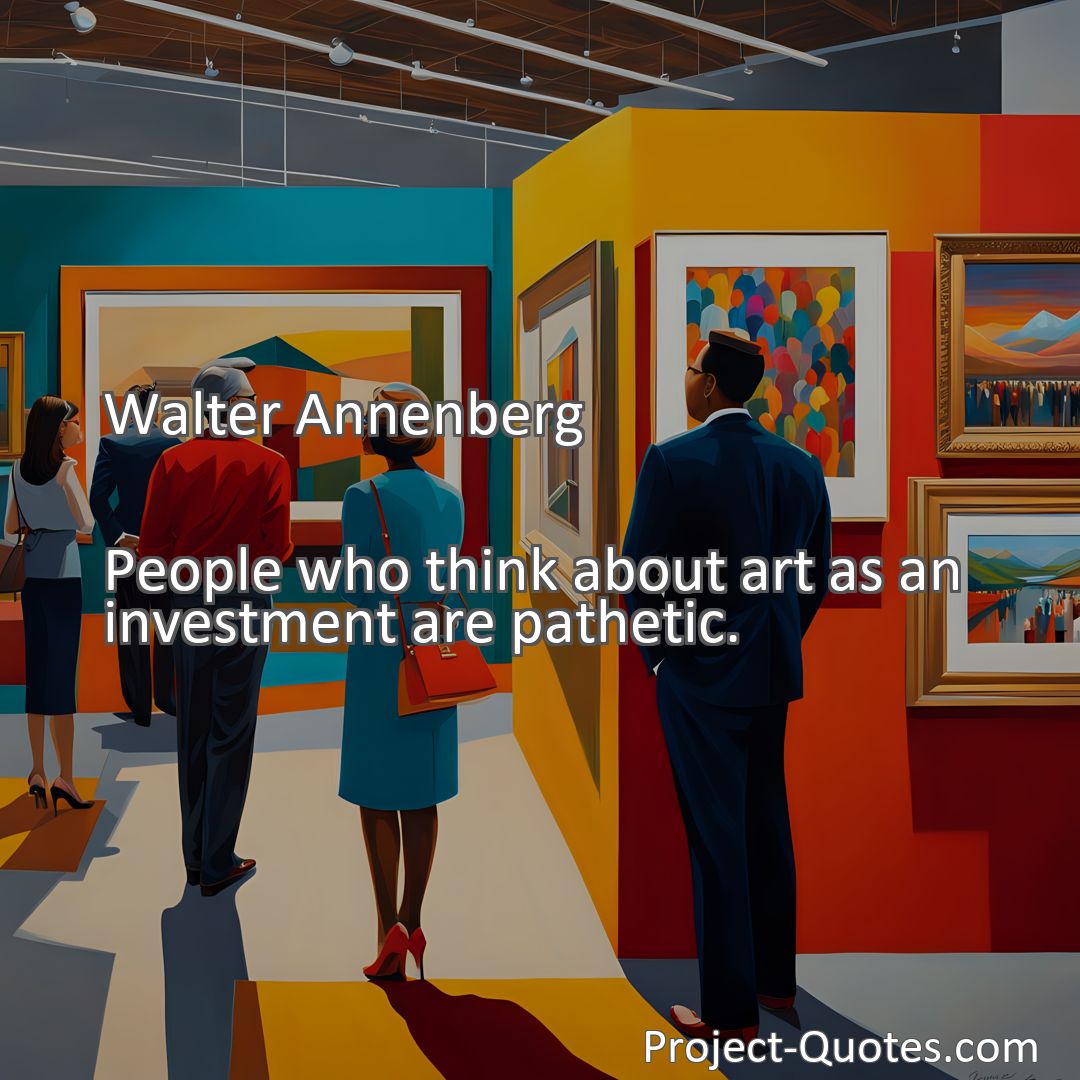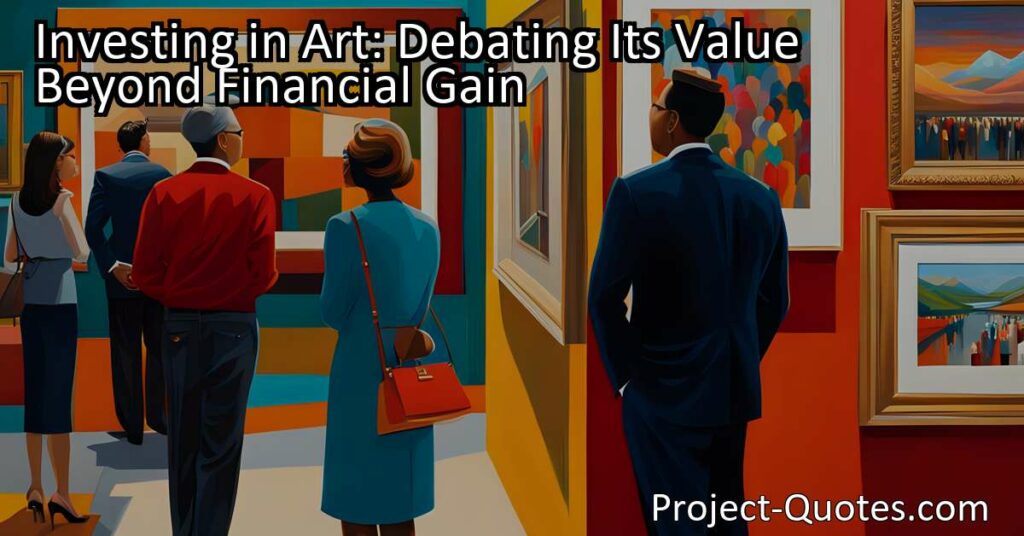People who think about art as an investment are pathetic.
Walter Annenberg
Investing in Art: Debating Its Value Beyond Financial Gain In today’s world, investing in art has become a topic of controversy. Walter Annenberg’s statement about it being “pathetic” raises the question of whether art should be viewed solely as a means to make money. While art can be financially rewarding, it is important to also appreciate its cultural, historical, and aesthetic significance instead of reducing it to a mere commodity.
Table of Contents
Meaning of Quote – People who think about art as an investment are pathetic.
In today’s world, there are various reasons why people may choose to invest their money – stocks, real estate, or even digital currencies like Bitcoin. However, when it comes to investing in art, a controversial statement like “People who think about art as an investment are pathetic” by Walter Annenberg, an American publisher, philanthropist, and art collector, might raise some eyebrows. This quote initiates a thought-provoking debate about the true value of art and whether it should be viewed solely as a financial asset.
Art has always had a significant place in human society, dating back thousands of years. It has the power to stir emotions, facilitate self-expression, and even challenge societal norms. But should its worth be confined to a price tag? Is it morally acceptable to view art purely as a means to make a profit, disregarding its cultural, historical, and aesthetic significance?
To understand Annenberg’s perspective, we must consider the economic reality surrounding the art world. Art auctions often make headlines with staggering prices for renowned pieces. For example, Leonardo da Vinci’s “Salvator Mundi” sold for a record-breaking $450 million in 2017. These eye-watering figures suggest that investing in art can be financially rewarding. However, this notion of art as a mere commodity can overshadow its intrinsic value and undermine the true essence of creativity.
Annenberg’s choice of words, describing those who view art as an investment as “pathetic,” may seem harsh. However, it highlights the concern that some individuals prioritize profit over appreciating the beauty and significance of artistic works. Instead of fostering an environment that values artistic expression and innovation, this perspective transforms art into a mere asset to be bought and sold.
Art connoisseurs argue that the true value of art lies beyond its monetary measurements. It encompasses the emotions and messages it conveys, the historical context it holds, and the impact it has on individuals and communities. Some argue that a painting or sculpture can be considered a window to the soul of the artist, offering a unique insight into their worldview, experiences, and struggles.
Moreover, art serves as an important cultural bridge, connecting people across time and space. Think about the enduring appeal of Van Gogh’s “Starry Night” or the enigmatic smile of Leonardo da Vinci’s “Mona Lisa.” These masterpieces have transcended generations, captivating audiences with their ability to create a universal language that surpasses boundaries.
Art can also challenge societal norms and spark important conversations. Throughout history, artists have used their works as a platform to criticize injustices, provoke thought, and push the boundaries of what is considered acceptable. From Pablo Picasso’s “Guernica” depicting the horrors of war to Frida Kahlo’s self-portraits challenging gender stereotypes, art has the power to provoke social change and inspire movements.
By reducing art to an investment, we risk diminishing its transformative potential and stifling creativity. If artists feel that their work will only be valued for its financial return, they may focus solely on meeting market demands, losing their ability to express themselves freely. This shift may lead to a homogenization of art, as artists produce works that are calculated to sell rather than provoke genuine emotional responses.
However, the reality is not black and white. Art collectors and investors, known as patrons, have played a crucial role throughout history in nurturing artistic talent and preserving cultural heritage. Their financial support has enabled artists to dedicate themselves to their craft and left us with priceless masterpieces today.
Additionally, investing in art can be seen as a way to contribute to the economy. It stimulates the art market, supports galleries, museums, and other cultural institutions, and creates employment opportunities for artists, curators, conservators, and other art professionals.
Furthermore, understanding the financial aspect of art can add another layer of appreciation. Learning about the market value and historical relevance of artworks allows individuals to make informed decisions while collecting or investing. It encourages a deeper engagement with the art world, expands knowledge, and promotes critical thinking.
Ultimately, the debate about art as an investment is complex and multifaceted. While some may find Annenberg’s statement harsh or provocative, it sheds light on the potential dangers of reducing art to a mere financial asset. Balancing the appreciation of art for its intrinsic qualities and recognizing its economic value is a delicate tightrope act that must be approached with care and thoughtfulness.
Perhaps, instead of categorizing individuals as “pathetic,” it would be more fruitful to encourage a broader dialogue that seeks to cultivate a well-rounded understanding of art. Art can indeed be an investment, but it should never overshadow its deeper value as a source of beauty, inspiration, and cultural enrichment. By nurturing both perspectives, we can preserve the essence of art and ensure that its significance transcends financial gain to continue inspiring generations to come.
I hope this quote inspired image brings you hope and peace. Share it with someone who needs it today!


